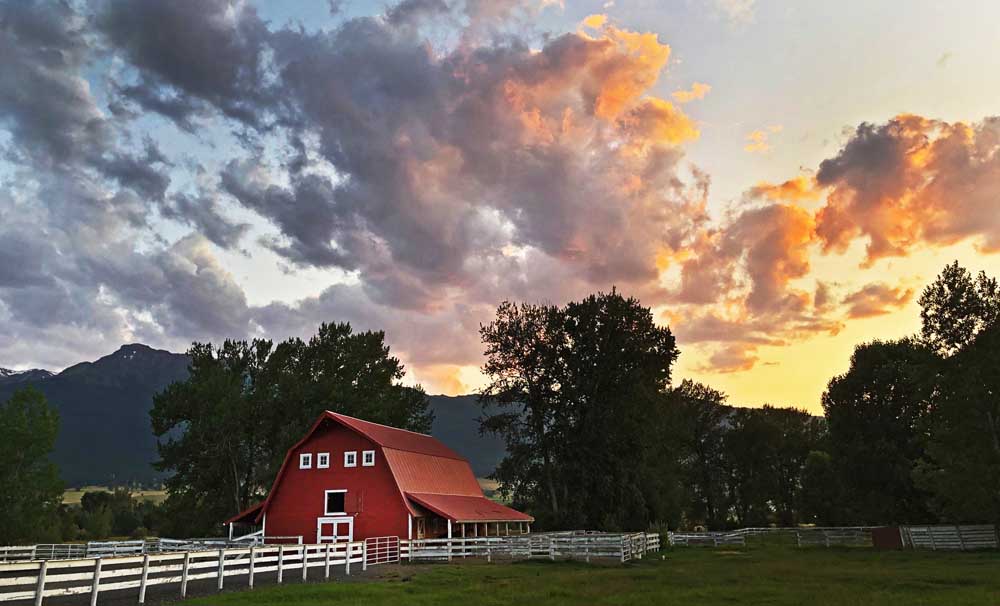FOG Outdoor Guide Fall Photography
Published 6:00 am Monday, September 23, 2019

- An early September shot that shows off-center symmetry, and features an interesting sky that is a major part of the image. If the sky was unclouded this image would be pretty uninteresting. iPhone 8 plus
“To me, photography is an art of observation. It’s about finding something interesting in an ordinary place… I’ve found it has little to do with the things you see and everything to do with the way you see them.”
– Elliott Erwitt
Trending
As summer slips into fall, our opportunities for shooting images change with the season. By being aware of the changes in light, nuances of color, and the shifting patterns of nature, you can capture some stunning outdoor images. Those images need not just be of landscapes. The variegated patterns of leaves, and even the increasingly bundled-up nature of your friends and family, can be great subjects to record.
And while you can use whatever photographic tools you have, you needn’t use a fancy camera to capture a sense of the season. Your phone can do the job just fine. The best camera is the one you have with you. And for most of us, that’s usually our cellphone. These handy devices have become credible photographic tools. They offer some actual advantages over more sophisticated cameras. Their small sensor means that they can capture great depth of field (the distance of the photo that is in sharp focus). They are generally unobtrusive unless you make a big fuss over holding them at arms length, and asking everyone to say “Cheese” or “Wallowa” before shooting. Most provide a nice wide angle lens. And most now allow you to shoot panoramas. (We won’t venture into the video thing, but they are quite amazing video cameras as well.) If you want to transform your cellphone into the functional equivalent of a DSLR, there are apps that you can download for free, or low cost, that allow you to vary the ISO, the shutter speed, and other parameters.
Here are some inspirational thoughts from extraordinary photographers, and some suggestions for places and features to capture. All the photos in this article were shot with my cellphone.
LIGHT
“Light makes photography. Embrace light. Admire it. Love it. But above all, know light. Know it for all you are worth, and you will know the key to photography.”
– George Eastman
Trending
Light is what sets fall apart from other seasons — lower sun, slanting light, golden mellow colors — partly from more smoke in the air (not from here this year but other places as far away as Siberia or China) and from the sunlight’s longer traverse through the Earth’s atmosphere. This time of low-angle slanting light is known as the “golden hour.” In mid-summer, it lasts a paltry 30-45 minutes, but as fall takes control, the sun scoots southward. Dawns arise slowly, sunsets linger and the low angles of light that produce landscape-defining shadows are available for longer. The warm nature of the light is an extra bonus for fall photographers.
You can take advantage of this when shooting landscapes that include the Wallowa Lake moraines, landscapes in the Wallowa Valley, places like Ladd Marsh or Kinney Lake, where there are reeds and waterscapes to hold the mellow light, but have their shapes better defined by shadows. Fall’s mellower and more subtle light is good for portraits, too.
Because the sun hangs lower in the sky, fall is also a great time to look for backlighted subjects. This is especially fun once trees – tamaracks, aspen, cottonwoods, maples, and even forest shrubs, begin to turn colors. Backlit images often have a special glow to them, more than a fully-sunlit grove of trees.
That low light combined with a bit of smoke in the air can sometimes lead to hazy photos, especially if you are shooting into the sun. When shooting backlit shots, make sure that your camera/phone is shaded, or that you are standing in the shade (and your camera/phone is too).
COMPOSITION
“Beauty can be seen in all things, seeing and composing the beauty is what separates the snapshot from the photograph.”
– Matt Hardy
Just as we can’t walk very far with out being balanced, a photograph won’t convey as much meaning without great composition. What do we mean by great composition?
There are lots of technical guidelines, but if you follow just three rules of thumb your photos will sing. First, don’t put the most interesting, central feature of your image (including Aunt Edna or Little Jimmy) smack in the middle of the photo. Why? Because you want the viewer to be pulled into the image, and some of that pulling comes from the eyes moving a bit to find the main feature. What fun is an Easter Egg hunt, for example, if all the chocolate eggs are plunked in a basket right in front of you? Second, use leading lines that draw the viewer deeper into your image. That might be a row of trees, a pattern in the grass, the lines of the moraines or lake shore, or clouds in the sky. And three, speaking of skies, skies are important —if they participate in the composition and if they tell part of the story. Clouds can even be the focal point of the picture. But avoid shooting an image that has a bounteous supply of nice, blue or nice gray sky up there all by itself.
GET CLOSE, THEN GET CLOSER
“If your pictures aren’t good enough, you’re not close enough.”
– Robert Capa
Often the problem of too much sky can be remedied by getting closer to your subject, whether a tree or a building or a person. The mantra of photojournalism is “Get close. Then get closer.” Closeness brings intimacy with your subject. Keep it in mind, no matter what the subject. This holds true with people as well as enticing fall subjects, including colorful leaves, that last bumblebee of the year holding fast to a bull thistle blossom, or a portrait of your dog.
EXPLORE DIFFERENT SCALES
“While there is perhaps a province in which the photograph can tell us nothing more than what we see with our own eyes, there is another in which it proves to us how little our eyes permit us to see.”
– Dorothea Lange
Photography captures subjects from mountain ranges (in fact, entire planets, nebulas and galaxies) to individual cells. While you can’t get much of an image of the Horsehead Nebula or Saturn on your cellphone, you CAN get great closeups and macro shots of leaves, flowers, insects and other small wonders that we don’t often take the time to view. Cellphones provide a great window into the small features that we often don’t take the time to examine.
Most cellphones allow the photographer to get within an inch or less of the subject, which makes for some excellent macrophotography.
The colors, patterns and even the states of decay of fall leaves, the vibrant colors of lichen celebrating a rain shower, a drop of water or a lone seed waiting to plunge from a lingering flower or colorful leaf are all worthy subjects. Take a look at the small things of fall. You’ll be amazed.
CAPTURE THE MOMENT
“Photography takes an instant out of time, altering life by holding it still.”
– Dorothea Lange
It’s fall. We tend to bundle up. This actually means that humans are sort of framing their faces for those of us with cameras. It means opportunities for candid shots. It also means that there are other moments, whether the first snowfall or swirling leaves in a just-right pattern, a telling glance, the instant of a fleeting smile, or a bumblebee poised for takeoff. Timing is everything in photography. Capturing and preserving the moment, along with composition and light makes for the very best, and most memorable photograph.
Whether you are hiking, hunting, riding or just enjoying a nice day, you’ve probably got your cellphone with you. Put it to work recording the season, your friends and family, and the world around you at different scales and from different angles. Chances are, you’ll be glad you did.
“Look and think before opening the shutter. The heart and mind are the true lens of the camera.”
— Yousuf Karsh









